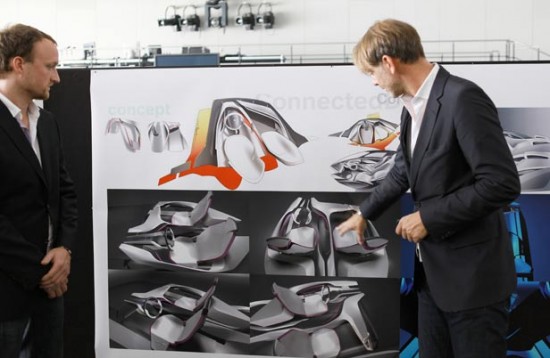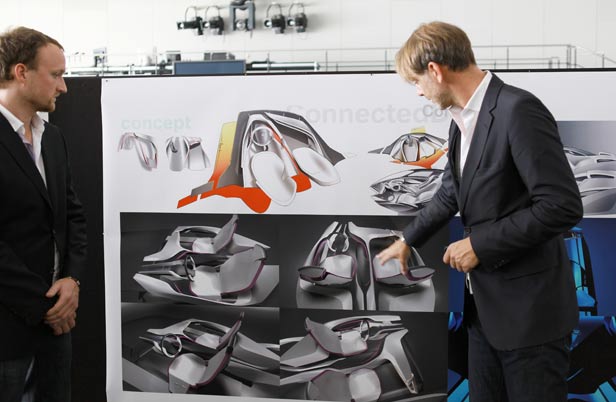Business Impact
Automobile Design for the Connected Age
BMW’s chief designer predicts that tomorrow’s cars will be controlled by voice commands, gestures, and touch screens.



Car design is in a state of flux. The designer’s job used to be about tail fins and chrome. Then it was all about cup holders and plastics. Today, as communication technology invades the vehicle, it’s just as much about user interfaces, flat-panel displays, and Hollywood animation tricks.
At BMW, the job of reimagining the relationship between car and driver belongs to Adrian Van Hooydonk, a 47-year-old industrial designer who was named the company’s design chief in 2009. Van Hooydonk oversees 500 designers worldwide from his headquarters at BMW DesignworksUSA, the Los Angeles studio that also plans the look of boats, planes, trains, and cell phones.
As a designer, Van Hooydonk says, he has always had to “live in the future.” The job, after all, is to imagine the style consumers will want in future vehicles and to guard that vision until the company reveals the product to the public. His fingerprints are on everything from the curves of BMW’s flagship 7 series sedans to sub-brands like Mini, Rolls-Royce, and a future line of hybrid-electric cars known as the iBrand.
Today, Van Hooydonk agrees, rapid developments in smart phones and consumer electronics have been challenging automakers to keep up. He spoke to reporter Tamara Warren at the North American International Auto Show in Detroit.
TR: Why did you become a car designer?
Van Hooydonk: I became an industrial designer first. I like to draw and to sketch and was always interested in the shape of things, the way things look and also the way things are made. I’m interested in cars because they are quite complicated, and they move under their own power. As a designer, then, you can see your work coming around the corner in any city around the world. You see the product in a different light when it’s on the move.
Good design sells cars. Is there evidence that good technology design also does?
We know that great technology design sells products. Apple is a big example. I think what’s happening in the consumer electronics business is that the way you operate cell phones is more of a character-defining factor than the form, or actual shape, of the cell phone. All cell phones are going to look like two pieces of glass. The user interface is becoming more important.
People will expect that same kind of seamlessness in the car. The steering wheel won’t go away for a while, but then how do you access all the other information? That is changing very rapidly. Right now in all our BMWs we have a big screen in the middle. In most of our cars we offer heads-up display, which is just like in a jet fighter. The most important information is right in front of you, projected on the road. In the future we’re going to do a whole lot more with displays in the car.
What will dashboard displays look like in 10 years?
I can very well imagine flexible displays. We will be able to integrate the displays into the shape of the dashboard. I hope that displays will get larger as well. There won’t be such a clear delineation between what is a button, what is a screen, and what is décor in a dashboard.
Now you have separate areas of buttons and controls on a dashboard. We hope that the dashboard becomes less of a block, and that it will be lighter. Another thing that will change in displays is the way we operate them. Voice control and gesture control are on the horizon already. This whole idea of pushing a button has already changed on computers, and it’s about to change on TVs. It will also change in cars.
The auto industry is used to designing car bodies and interiors. How has in-car technology and connectivity changed your job?
It adds another dimension. We’re seeing more and more screens pop up in the cars, including the heads-up display. The design department that I head is designing all the images that appear on those screens. And our design process has gone from 2-D to 3-D. It’s complete animation. We’re in need of a different type of designer. In L.A. you can find animation artists, because the movie industry needs them as well. That’s who we’re looking at. You almost need to make a script before you start designing what’s happening on the screen. You need to know about filming and camera angles and animation, how you make things change or transition on the screen.
What is the look that captures connectivity? Does it vary from brand to brand?
It does vary. It looks different in a Mini than it does in a BMW. We are fully aware that the user interface or the user experience will tell as much about the brand as a mirror or door handle or actually operating the car. The Mini looks a bit more colorful and playful, and even the icons on the screen are more playful, funny. The icons spin around on the screen. Whereas on the BMW it’s a little more technical, a little more rational.
Many current systems, like BMW’s iDrive, use Bluetooth to connect with the phone of the driver, something brought from outside into the car. What does that mean for design?
It is tricky, because technology and the consumer electronics industry are changing faster than car design does. We build a new car every eight years. Cell-phone companies build a new phone every year. They have very different cycle times, so it’s hard to keep up. Bluetooth was a big step forward; we found a way that newer cell phones can communicate with cars. The next step is the cloud, so you don’t even need your phone anymore to access your music or address book. The next step is where you can access information in the car without a cell phone.
Regulators in the U.S. are worried that there is too much technology going into cars, and too many distractions for drivers. How does design address this problem?
We have that concern as well. As much as we like to give drivers a really nice, colorful user interface with lots of animation, we are also very concerned about having them operate in a safe way. In the end, it will be a trade-off. We can’t do as much as on a computer screen that you use when you sit at home on the couch. The car is a driving environment. This is why BMW is pushing the heads-up display. The information that is crucial to the driver, especially safety warnings, comes up.